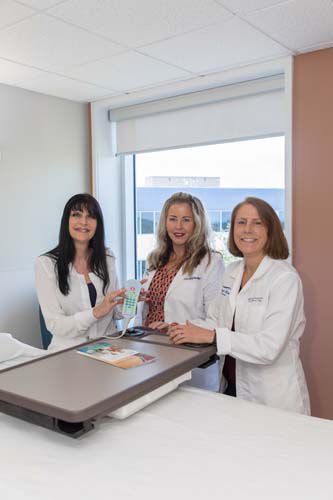
Hospitals are among the most watched and regulated entities in the country. Dozens of federal, state and local agencies are involved in hospital regulation and oversight.
Together they poke, prod and otherwise examine every aspect of every hospital’s day-to-day operations including the broad topic of patient safety.
Almost all those various agencies then rate or rank each hospital based on their findings.
That is just fine with Dr. Katherine Grichnik, who took over as chief medical officer for the Indian River Medical Center in January, and registered nurse Barbara Sills, a 24-year veteran of the Vero healthcare facility who serves as nursing administrative supervisor for the hospital.
In April 2016, before she took the IRMC post, Becker’s Hospital Review named Grichnik “one of 50 top experts in the field of patient safety,” and in her first interview in Vero in January, Grichnik said her “absolute passion is the culture of safety.”
Now that her new team – and teamwork is a recurring theme in almost all of Grichnik’s comments – has had some time together, Grichnik and Sills sat down to talk about some of the ways they help keep patients safer than ever during an IRMC hospital stay.
New safety measures include an impressive “nurse call” system, procedures to prevent patient falls, a medication management program and infection prevention.
This nurse call system, says Sills, “is new to us” and she calls it both “patient and staff-friendly.”
This system, she says, allows the patient to ask for what they want or need just by pressing a button with easy-to-see images on it. The system also tracks each individual call’s response times, which may well help foster new ways of meeting and exceeding the hospitals goals and drive future improvements and innovations.
While all that is certainly convenient for patients, it might be fair to ask what it has to do with safety.
Grichnik jumps in to explain.
When nature calls, she points out, some patients – who should not be getting out of bed on their own for any reason – will very often try anyway and statistics show that far too many of them will immediately fall and very possibly injure themselves.
Patient falls are clearly a hot-button issue with Grichnik.
“We view falls as a preventable issue,” Grichnik says, “and we analyze every single fall. Every. Single. Fall. That is a part of a rapid cycle improvement program that I think we really started in January.”
Meanwhile, borrowing from the best in the business, Grichnik adds that IRMC is now using the Johns Hopkins fall-risk safety score. Every patient is scored on it almost as soon as they come into the hospital. “We’ve also developed [another] program,” Grichnik adds. “Should the patient’s fall risk get to a certain level, my office, the supervisor’s office and housekeeping all get a notification saying, ‘Room 425 needs a lowboy bed.’”
The lowboys are much closer to the ground and padding can be provided around it on the floor to further reduce any injury risk from a fall.
Medication errors and infections also pose problems for every hospital in the country and Grichnik’s team is tackling both those issues head-on. As far as infections are concerned, the chief medical officer adds, “We have also had a huge focus since the beginning of the year to help prevent infections” in the first place.
Something seems to be working.
In April, IRMC received an “A” rating for patient safety from the nonprofit Leapfrog hospital safety study. But with other – and some say tougher – rankings coming up, Grichnik, Sills and their IRMC team are working to set new and even higher standards for the Vero hospital.
With a chief medical officer at the helm whose “absolute passion is the culture of safety,” that probably shouldn’t be a surprise to anyone.



